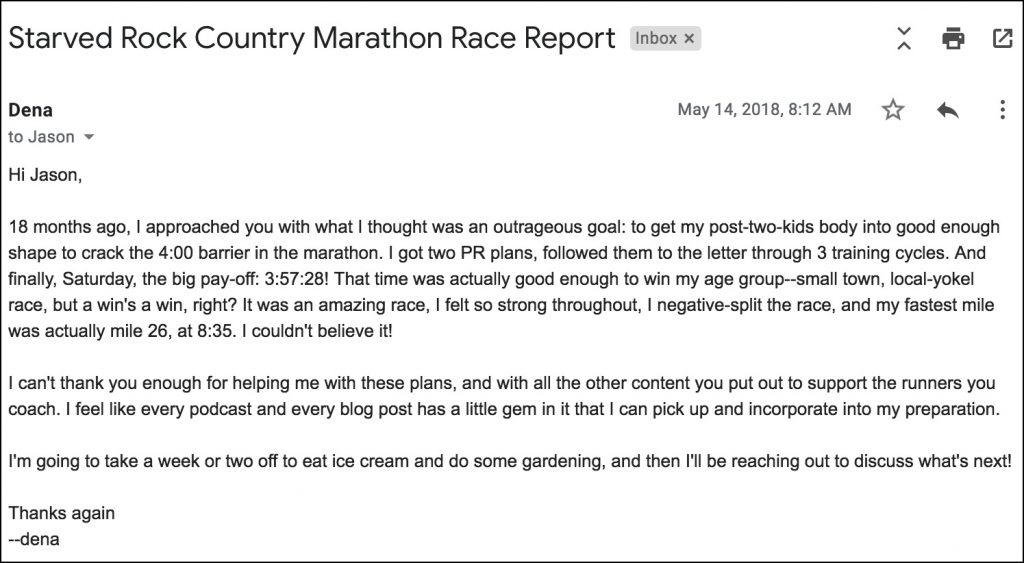Running is exciting because it’s cumulative; what you do this week helps you next month. And your training next month helps you next year!

Like compound interest, training benefits increase with time. The physical systems (let’s not also forget mental and emotional) that enable fast races and injury resilience take years to properly develop.
That’s why some elite-level coaches tell their athletes that it takes 2-3 years after college to even glimpse their potential!
But there are ways to accelerate this process and experience even faster progress.
While there are no shortcuts, there are certainly best practices that lead to better results. And in this article, I want to introduce you to a powerful way of making accelerated progress.
This can be done by using performance multipliers.
Performance multipliers multiply your efforts, give you several benefits at once, and make improvement easier with virtually no drawbacks.
Just imagine going to bed an hour earlier. You’ll recover faster from your previous training, adapt to that training more effectively, and feel better during your next workout.
But the benefits don’t just stop there. Getting the right amount of sleep will:
- Improve mood, concentration, focus, and the many attributes that comprise “mental fitness”
- Help you live longer
- Boost your ability to lose weight by improving fat loss
A healthy sleep habit is a “performance multiplier” that improves many aspects of physical, mental, and emotional health.
Just do that one thing (get more sleep) and you’ll get a whole host of advantages.
What Strategies Don’t Count?
Performance Multipliers lead to progress
Not every training tool is a performance multiplier. In fact, some tried and true strategies have so many downsides that they should be used sparingly!
Just consider a fast workout. Many runners assume that you have to run faster workouts to race faster.
And it’s true that structured, formal workouts (like fartlek training, track intervals, or hill workouts) will improve your speed.
But they have a cost. Workouts:
- Increase fatigue
- Cause muscular damage, resulting in soreness
- Spike your injury risk
Workouts should be considered a necessary but risky part of training. You can’t reach your potential without running fast occasionally but they certainly have drawbacks.
High mileage and long runs are also necessary to achieve your potential. But like speed sessions, they have substantial risks.
Performance multipliers don’t have these substantial downsides. They’re strategies that give you many benefits with virtually no risk.
How to Identify Performance Multipliers
A performance multiplier stands out for two major reasons:
- It has multiple benefits
- It has few (or zero) drawbacks
In our example above, we saw that fast workouts have one major advantage (greater speed) but there’s a catch: they have a lot of downsides.
While speed workouts are necessary, they must be used sparingly.
In contrast, a performance multiplier like sleep is a win-win-win strategy with no downsides!
Strength training is another performance multiplier that can improve your running in a variety of ways:
- More strength and power to kick and race fast
- The best non-training way to prevent injuries
- Improved economy (efficiency)
In a recent video about how to engineer your own performance breakthrough, I mentioned strength training:
Notice how I said it’s an indirect way of getting faster and that it helps improve your form, strength, coordination, injury resilience, and ability to tolerate a higher workload.
That, my friend, is a performance multiplier.
Cross-training is yet another example of a powerful performance multiplier. Exercise like pool running or cycling can further develop your endurance with virtually no injury risk.
In fact, cross-training led to my best season of cross country in college. With an extra 3-4 hours of cycling and aqua-jogging per week (and a mandated 9 hours of sleep per night), I was able to run faster and more consistently than any season prior.
I made our very competitive Varsity team, improved my 8k cross country PR, and had a lot of fun that season!
The only thing that cross-training costs you is time. If you have extra time, adding it to your training program is a no-brainer.
“Stacking” Improvement for More Speed
You can tell when a runner has been focusing on performance multipliers. They make big strides forward (excuse the running pun), racking up Personal Records while staying healthy and feeling strong.
Just look at this email I received:

It’s not easy to run a Personal Best. Especially in the marathon after two kids! Dena took advantage of Strength Running training programs that stack these performance multipliers and make success easier to achieve.
When you include as many of these strategies as you can in your training, you’ll feel the difference.
This week, I’m putting together more coaching material on the topic of a specific performance multiplier: nutrition.
You see, better nutrition is one of the best ways to magnify growth and accelerate your progress.
That’s because sound nutrition:
- Improves general health and feelings of well-being
- Fuels every run, strength session, and cross-training workout you do
- Boosts energy levels throughout the day
- Increases your body’s ability to recover from exercise
And the best part? There are absolutely no drawbacks, disadvantages, or negative side-effects of eating well! You won’t get sore, fatigued, or risk an injury.
I’m bullish on proper nutrition for runners because there is no downside – only upside – to eating a more nutrient-dense diet.
To get started with our series this week, sign up here for your first lesson.
I’ll also be sharing more advice on social media, so don’t miss anything:
If you’re ready to accelerate your progress with this performance multiplier, I’m ready to help you transform your running.
I think this is going to be a huge turning point in your running career so get excited!
Make sure you’re on the Strength Running Team to get the best stuff – just sign up here and I’ll take care of sending you the first coaching lesson.